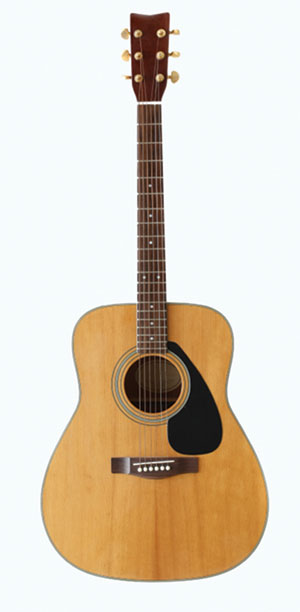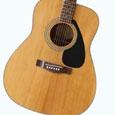 My father was a musician – he could play guitar, bass, piano, write songs and sing. He tried to teach me these skills, but I was stubborn and resisted. By age 13 I had chosen the saxophone, and my father gave up trying to influence my musical development. For the remainder of high school and college the idea of learning the guitar never crossed my mind.
My father was a musician – he could play guitar, bass, piano, write songs and sing. He tried to teach me these skills, but I was stubborn and resisted. By age 13 I had chosen the saxophone, and my father gave up trying to influence my musical development. For the remainder of high school and college the idea of learning the guitar never crossed my mind.
It was not until I began my teaching career in Bluegrass country in rural Missouri that I started thinking about developing a guitar class. The idea stayed in mind for another couple of years as I moved on to another school in extreme western Kansas. I decided that even though I had no experience on guitar, the time was right to develop such a class for students who needed a fine arts credit to graduate.
I was amazed at how many students jumped at the opportunity to learn the instrument. Even with the initial curiosity, I knew that a classical approach would not hold student attention. A survey of students indicated that they wanted to learn how to play the songs they heard on their iPods. It was no different for me when I was young, back when MTV still played music.
To build interest in the guitar program, I started posting whimsical posters around the school (“Got Guitar?”). As students started showing genuine interest, I reminded them that if they signed up for the class, they would in essence get five hours of free guitar lessons a week. Once the word was out, it was time to sell the administration on the program.
Most administrators love facts, figures, and cost estimates when evaluating new proposals. After making an appointment to discuss the new program, I prepared carefully. I had absolute confidence that this was the right next step for the school and the music program. I was not going to take no for an answer.
As I went through the variety of education benefits that would result from the program, the administrator just kept nodding. It appeared that all of my carefully prepared arguments were failing. Everything turned around when I disclosed that the program would cost almost nothing. Students would provide their own guitar (electric or acoustic), and the electric guitarists would bring their own amplifier and cable. I expected students to purchase books, picks, tuners, extra strings, and other accessories. All I wanted from the school was a slot in the daily schedule.
When I initially sold the program, I was not prepared to give a complete curriculum for the year. I emphasized that the first year would involve considerable trial and error, making adjustments to meet student expectations for the program. Although I did not say it out loud, I was a rookie teaching rookies. Because I had never even played guitar, I knew the first year would have to be flexible.
Day One
On the first day I found myself watching the clock anxiously, waiting for the 4th hour to arrive. When the bell rang students came in droves, and I had 36 students waiting to become guitar heroes. I was excited but also felt nervous and stammered a bit through that first class. I promised myself in advance that I would not pretend to be a guitar expert. I simply sat down, introduced myself, assigned someone to take daily attendance, and handed out the syllabus. I began with a simple question: “Why do you want to be a guitar player?” The answers ranged from “to meet girls” to “because it is cool!”
As I started I wanted students to know that I had no prior experience on guitar. I told students that we would be on the same level for a while. I knew that my background as a performance major would allow me to stay ahead of the class. Daily guitar practice became part of my routine because I did not want the class to surpass my skills and leave me on the dusty Kansas plain. Eventually, some of the students did surpass my abilities; the best feeling in the world. There is nothing greater than watching motivation and excitement grow as students learn something new.
A Flexible Curriculum
For the first couple of years, I based my curriculum almost entirely on the first two books of the Hal Leonard Guitar Series, supplemented with additional materials on rock guitar and power chords. Students wanted to learn how to solo, compose their own music, and read guitar tablature. I found the latter interesting because the method book is written in standard notation. Some students in the class had a few years of band under their belt and found reading standard notation quite easy. The rest made faster progress using the guitar tablature.
I purchased guitar tablature software so I could write exercises in this format. Within a few years I had dozens of rewritten exercises. When I first realized that students were struggling, I asked what needed to change. Without blinking an eye all of them stated that reading notation was slowing them down because they would never really use it after high school. They just wanted to gain as much information as possible on how to play the guitar. Their wish was my command and after making the change to guitar tablature, the program began to take off.
Adding Variety
It was important to me that the curriculum provide as comprehensive a view of guitar playing as possible. With the help of the internet, articles, interviews, with university guitar instructors, and music DVDs, I was able to construct a sizable unit on the origins of the guitar and its use in American music. I also found a wealth of research papers on such important guitar players as Jimi Hendrix, Django Reinhardt, John William, and Yngwie Malmsteen. I also spent time introducing and researching the various components of the guitar, various types of wood used, the layout of the fret board, tuning, and how to restring a guitar.
The curriculum in those first years allowed me to adapt and modify instruction based on the motivation of the class. It quickly became apparent that not everyone was in the program to learn the guitar to become a musician. Some just needed the credit to graduate. Knowing that the administration required facts and figures to justify the program, I showed progress through regular informal assessments, weekly playing exams, practice logs, and public performances.
Public Concerts
We give a Christmas concert and a spring concert each year, but perhaps the most fun we have as a class is an annual Christmas tour to various group homes, veteran’s hospitals, and senior centers. We treat the tour like a professional gig – we are out the door by 7 a.m. and home by 5 p.m. Last year we managed to travel to six shows in five different towns. The schedule was so busy that I found myself stumbling over my words by the last event.
The concept of a Christmas tour has been a part of my teaching from the very beginning. Long before I taught a guitar class, I took small band ensembles to play in different parts of the state. I found that older audiences actually prefer the guitar ensemble because the guitar sound is less overwhelming than brass instruments. The concerts help promote community awareness of the guitar ensemble and at this point many places contact us to set up another performance. Students also benefit from feeling like professional musicians. The tours are all business, and students know I expect adult behavior when we are out in the community.
Practice Logs
I tell students at the beginning of each year that they will only get out of the guitar what they put into it. We meet five days a week for a full hour, but it is essential that they practice on their own. I tell them that to be an okay guitar player might require 30 minutes a day. If you want to be great, you have to practice for hours. Some of my most dedicated players clock in three hours a night on their practice log. These students start as beginners, tap into playing serious solos in just a few months, and discover that they love playing.
No Pain, No Gain
I make sure young players know from the start that playing guitar involves some physical pain. They are pushing metal strings in between two metal frets so it takes some pressure on the strings to produce a clear tone. Repeating this over and over develops calluses on the fingers but it does not happen overnight. It takes a few weeks for the fingers to harden from the repeated thrashing on an acoustic guitar. With an electric guitar, there is less initial pain because the strings are lower to the fretboard and require less pressure. I always tell students that if your fingers are not hurting a little bit after the first couple of days with the instrument, you are not working hard enough. You can tell by the sound if a student is not pushing hard enough on the string.
Moving Forward
Seven years have passed since the my first guitar class. Those early years of teaching guitar in Kansas made me appreciate the dedication needed to promote a new type of class. I discovered that I was the only director in Western Kansas who was brave or crazy enough to teach a daily guitar class. Even as a trained band director, I felt some fear of the unknown. I worried about giving students an excellent guitar education because I lacked experience with the instrument.
I laugh now at how much I did not know in the beginning and how much higher my expectations have become for students. The curriculum has been completely overhauled. I no longer use a published method book but have developed my own that I hand out on the first day. The book is written so that it can be adapted to meet the learning curve of each class from year to year. For seven years my guitar class has been a remarkable experiment and adventure. I encourage more directors to give it a try.





